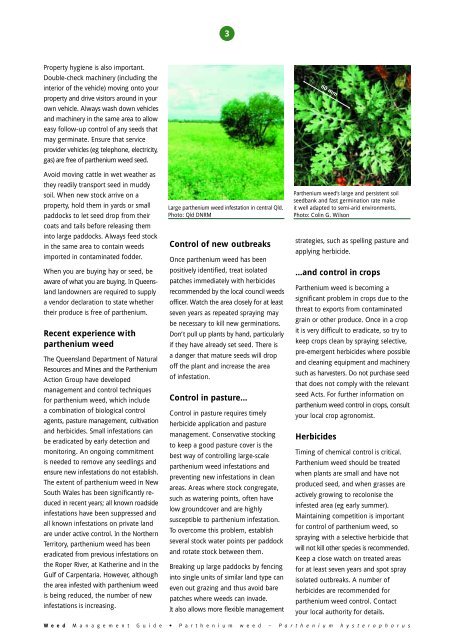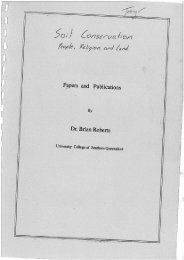Parthenium weed (Parthenium hysterophorus) - South West NRM
Parthenium weed (Parthenium hysterophorus) - South West NRM
Parthenium weed (Parthenium hysterophorus) - South West NRM
Create successful ePaper yourself
Turn your PDF publications into a flip-book with our unique Google optimized e-Paper software.
3<br />
Property hygiene is also important.<br />
Double-check machinery (including the<br />
interior of the vehicle) moving onto your<br />
property and drive visitors around in your<br />
own vehicle. Always wash down vehicles<br />
and machinery in the same area to allow<br />
easy follow-up control of any seeds that<br />
may germinate. Ensure that service<br />
provider vehicles (eg telephone, electricity,<br />
gas) are free of parthenium <strong>weed</strong> seed.<br />
Avoid moving cattle in wet weather as<br />
they readily transport seed in muddy<br />
soil. When new stock arrive on a<br />
property, hold them in yards or small<br />
paddocks to let seed drop from their<br />
coats and tails before releasing them<br />
into large paddocks. Always feed stock<br />
in the same area to contain <strong>weed</strong>s<br />
imported in contaminated fodder.<br />
When you are buying hay or seed, be<br />
aware of what you are buying. In Queensland<br />
landowners are required to supply<br />
a vendor declaration to state whether<br />
their produce is free of parthenium.<br />
Recent experience with<br />
parthenium <strong>weed</strong><br />
The Queensland Department of Natural<br />
Resources and Mines and the <strong>Parthenium</strong><br />
Action Group have developed<br />
management and control techniques<br />
for parthenium <strong>weed</strong>, which include<br />
a combination of biological control<br />
agents, pasture management, cultivation<br />
and herbicides. Small infestations can<br />
be eradicated by early detection and<br />
monitoring. An ongoing commitment<br />
is needed to remove any seedlings and<br />
ensure new infestations do not establish.<br />
The extent of parthenium <strong>weed</strong> in New<br />
<strong>South</strong> Wales has been significantly reduced<br />
in recent years; all known roadside<br />
infestations have been suppressed and<br />
all known infestations on private land<br />
are under active control. In the Northern<br />
Territory, parthenium <strong>weed</strong> has been<br />
eradicated from previous infestations on<br />
the Roper River, at Katherine and in the<br />
Gulf of Carpentaria. However, although<br />
the area infested with parthenium <strong>weed</strong><br />
is being reduced, the number of new<br />
infestations is increasing.<br />
Large parthenium <strong>weed</strong> infestation in central Qld.<br />
Photo: Qld D<strong>NRM</strong><br />
Control of new outbreaks<br />
Once parthenium <strong>weed</strong> has been<br />
positively identified, treat isolated<br />
patches immediately with herbicides<br />
recommended by the local council <strong>weed</strong>s<br />
officer. Watch the area closely for at least<br />
seven years as repeated spraying may<br />
be necessary to kill new germinations.<br />
Don’t pull up plants by hand, particularly<br />
if they have already set seed. There is<br />
a danger that mature seeds will drop<br />
off the plant and increase the area<br />
of infestation.<br />
Control in pasture...<br />
Control in pasture requires timely<br />
herbicide application and pasture<br />
management. Conservative stocking<br />
to keep a good pasture cover is the<br />
best way of controlling large-scale<br />
parthenium <strong>weed</strong> infestations and<br />
preventing new infestations in clean<br />
areas. Areas where stock congregate,<br />
such as watering points, often have<br />
low groundcover and are highly<br />
susceptible to parthenium infestation.<br />
To overcome this problem, establish<br />
several stock water points per paddock<br />
and rotate stock between them.<br />
Breaking up large paddocks by fencing<br />
into single units of similar land type can<br />
even out grazing and thus avoid bare<br />
patches where <strong>weed</strong>s can invade.<br />
It also allows more flexible management<br />
60 mm<br />
<strong>Parthenium</strong> <strong>weed</strong>’s large and persistent soil<br />
seedbank and fast germination rate make<br />
it well adapted to semi-arid environments.<br />
Photo: Colin G. Wilson<br />
strategies, such as spelling pasture and<br />
applying herbicide.<br />
...and control in crops<br />
<strong>Parthenium</strong> <strong>weed</strong> is becoming a<br />
significant problem in crops due to the<br />
threat to exports from contaminated<br />
grain or other produce. Once in a crop<br />
it is very difficult to eradicate, so try to<br />
keep crops clean by spraying selective,<br />
pre-emergent herbicides where possible<br />
and cleaning equipment and machinery<br />
such as harvesters. Do not purchase seed<br />
that does not comply with the relevant<br />
seed Acts. For further information on<br />
parthenium <strong>weed</strong> control in crops, consult<br />
your local crop agronomist.<br />
Herbicides<br />
Timing of chemical control is critical.<br />
<strong>Parthenium</strong> <strong>weed</strong> should be treated<br />
when plants are small and have not<br />
produced seed, and when grasses are<br />
actively growing to recolonise the<br />
infested area (eg early summer).<br />
Maintaining competition is important<br />
for control of parthenium <strong>weed</strong>, so<br />
spraying with a selective herbicide that<br />
will not kill other species is recommended.<br />
Keep a close watch on treated areas<br />
for at least seven years and spot spray<br />
isolated outbreaks. A number of<br />
herbicides are recommended for<br />
parthenium <strong>weed</strong> control. Contact<br />
your local authority for details.<br />
W e e d M a n a g e m e n t<br />
G u i d e • P a r t h e n i u m w e e d – P a r t h e n i u m h y s t e r o p h o r u s

















